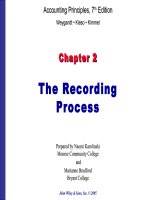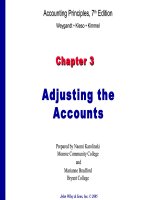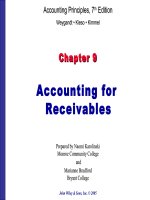Accounting principles 7th kieso kimel chapter 01
Bạn đang xem bản rút gọn của tài liệu. Xem và tải ngay bản đầy đủ của tài liệu tại đây (543.54 KB, 52 trang )
Accounting Principles, 7th Edition
Weygandt • Kieso • Kimmel
Chapter 1
Accounting in Action
Prepared by Naomi Karolinski
Monroe Community College
and
Marianne Bradford
Bryant College
John Wiley & Sons, Inc. © 2005
CHAPTER 1
ACCOUNTING IN
ACTION
After studying this chapter, you should be able to:
• 1 Explain what accounting is.
• 2 Identify users and uses of accounting.
• 3 Understand why ethics is a
fundamental business concept.
• 4 Explain the meaning of generally
accepted accounting principles and the
cost principle.
CHAPTER 1
ACCOUNTING IN
After studying thisACTION
chapter, you should be able to:
• 5 Explain the meaning of the monetary unit
assumption and the economic entity
assumption.
• 6 State the basic accounting equation and
explain the meaning of assets, liabilities, and
owner’s equity.
• 7 Analyze the effect of business transactions
on the basic accounting equation.
• 8 Understand what the four financial
statements are and how they are prepared.
WHAT IS
ACCOUNTING?
STUDY OBJECTIVE 1
• Accounting is an information system
that
• Identifies
• Records
• Communicates the economic events
of an organization to interested users
THE ACCOUNTING
PROCESS
QUESTIONS ASKED BY
INTERNAL USERS
STUDY OBJECTIVE 2
QUESTIONS ASKED BY
EXTERNAL USERS
BOOKKEEPING
DISTINGUISHED FROM
ACCOUNTING
• Accounting
Includes bookkeeping
Also includes much more
• Bookkeeping
The recording of economic events
One part of accounting
•
THE ACCOUNTING
PROFESSION
Public Accountants
Service to the general public through the services they
perform.
• Private Accountants
Individuals in companies involved in activities
including cost and tax accounting, systems, and
internal auditing.
• Not For Profit Accountants
Reporting and control for government units,
foundations, hospitals, labor unions,
colleges/universities, and charities.
THE BUILDING BLOCKS OF
ACCOUNTING
•
STUDY OBJECTIVES 3, 4 & 5
Ethics
Standards by which actions are judged as right or wrong,
honest or dishonest.
•
Generally Accepted Accounting Principles
Established by the F.A.S.B and the S.E.C.
•
Assumptions
–
–
Monetary Unit
Only data that can be expressed in terms of money is
included in the accounting records.
Economic Entity
Includes any organization or unit in society.
BUSINESS
ENTERPRISES
• Proprietorship
Owned by one person.
• Partnership
Owned by two or more persons.
• Corporation
Organized as a separate legal entity under state
corporation law and having ownership divided into
transferable shares of stock.
The accounting process is correctly
sequenced as
a.
b.
c.
d.
Chapter 1
identification, communication, recording.
recording, communication, identification.
identification, recording, communication.
communication, recording, identification.
The accounting process is correctly
sequenced as
a.
b.
c.
d.
Chapter 1
identification, communication, recording.
recording, communication, identification.
identification, recording, communication.
communication, recording, identification.
BASIC ACCOUNTING
EQUATION
STUDY OBJECTIVE 6
Assets
=
Liabilities
+
Owner’s Equity
ASSETS
BUILDING
AS A
BLOCK
• Assets are resources owned by a
business.
• They are used in carrying out such
activities as production,
consumption and exchange.
LIABILITIES AS A
BUILDING BLOCK
•
Liabilities
• are creditor claims against assets
• are existing debts and obligations
OWNER’S EQUITY AS A
BUILDING BLOCK
• Owner’s Equity = total assets minus
total liabilities. (A - L = O.E.)
• Owner’s Equity represents the
ownership claim to total assets.
• Subdivisions of Owner’s Equity:
1 Capital or Investments by Owner (+)
2 Drawing (-)
3 Revenues (+)
4 Expenses (-)
INVESTMENTS BY OWNERS
AS A BUILDING BLOCK
•
Investments
• are the assets the owner puts in the
business
• increase owner’s equity
DRAWINGS AS A BUILDING
BLOCK
•
Drawings
• are withdrawals of cash or other assets by the
owner for personal use
• decrease owner’s equity
REVENUES AS A
BUILDING BLOCK
•
Revenues
• gross increases in owner’s equity from
business activities entered into for the
purpose of earning income
• may result from sale of merchandise,
services, rental of property, or lending
money
• usually result in an increase in an asset
EXPENSES AS A
BUILDING BLOCK
Expenses
• decreases in owner’s equity that result from operating
the business
• cost of assets consumed or services used in the process
of earning revenue
• examples: utility expense, rent expense, supplies
expense, and tax expense
INCREASES AND
DECREASES IN
OWNER’S EQUITY
•INCREASES
Investments
by Owner
Revenues
DECREASES
Owner’s
Equity
Withdrawals
by Owner
Expenses
TRANSACTION
IDENTIFICATION PROCESS
STUDY OBJECTIVE 6
TRANSACTION ANALYSIS
TRANSACTION 1
• Ray Neal decides to open a
computer programming service.
• On September 1, he invests $15,000
cash in the business, which he
names Softbyte.
Softbyte
TRANSACTION ANALYSIS
TRANSACTION 1 SOLUTION
•
Assets
=
Liabilities
Cash
+ Owner’s Equity
R. Neal,
Capital
+ 15,000
$15,000
Investment
=
+ 15,000
$15,000
There
Thereisisan
anincrease
increasein
inthe
theasset
assetCash,
Cash,
$15,000,
$15,000,and
andan
anequal
equalincrease
increasein
inthe
theowner’s
owner’s
equity,
equity,R.
R.Neal,
Neal,Capital,
Capital,$15,000.
$15,000.









